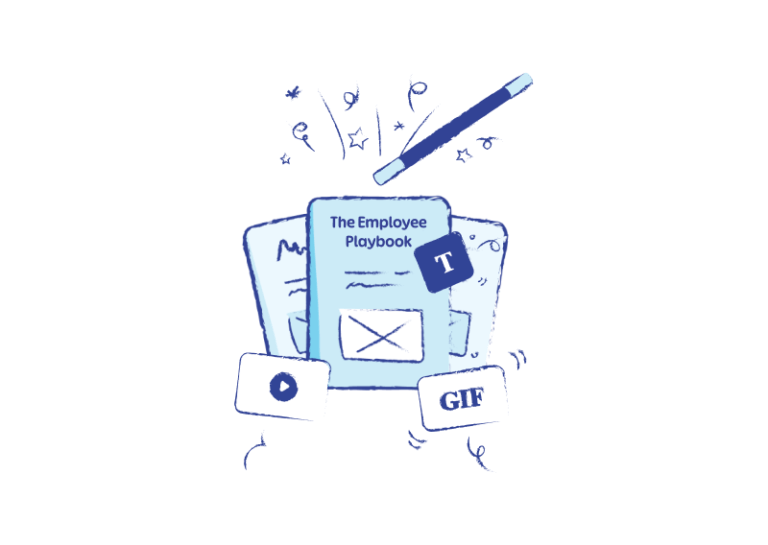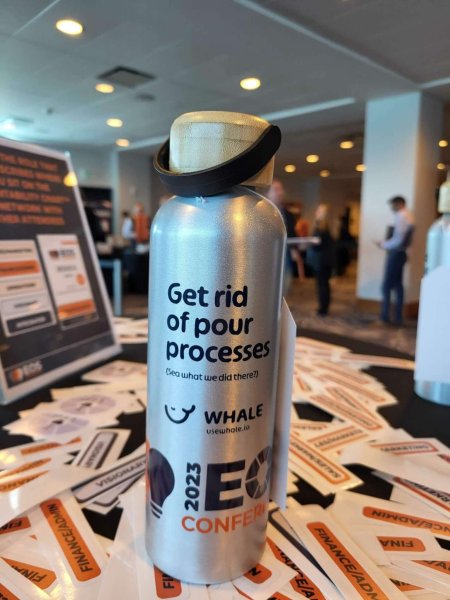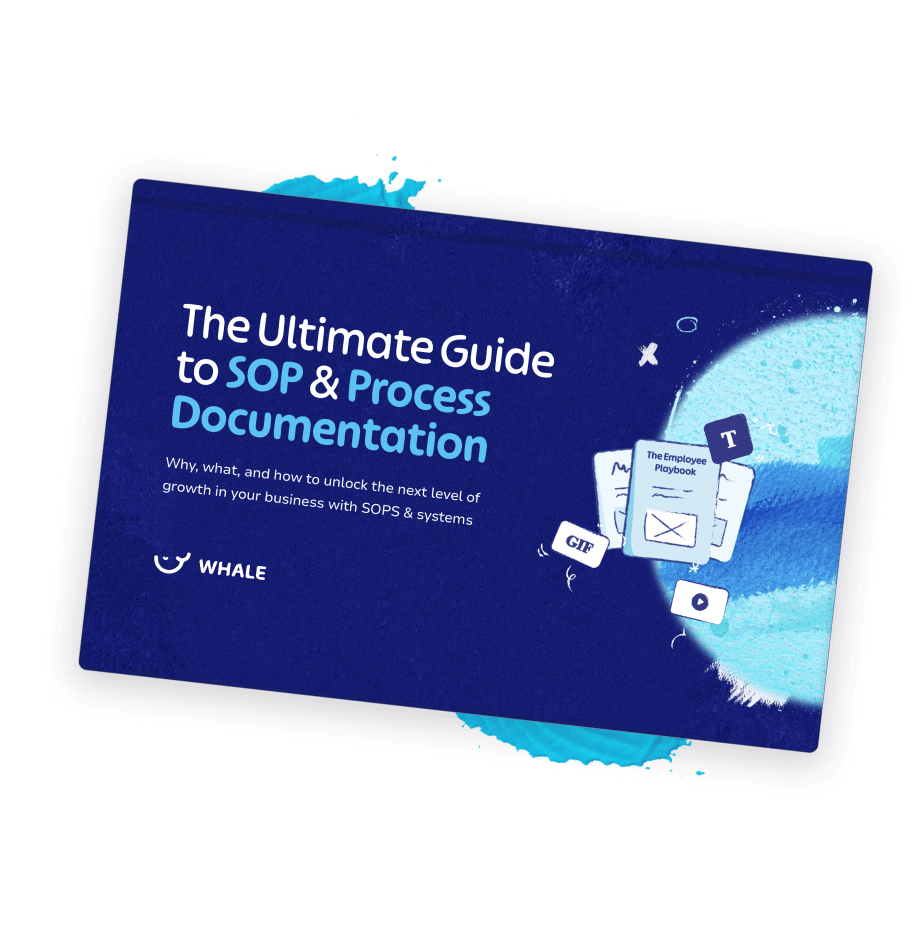The state of employee burnout
Employee burnout is rife!
Many professionals — one Deloitte study puts the number at 77% — have experienced burnout.
And yet 70% of employees still don’t think companies are doing enough to solve the problem.
Things need to change.
And with the right procedures and initiatives in place, they can.
From putting employee experience first, to supporting workers with great Standard Operating Procedures (SOPs), there are a million and one ways to reduce employee burnout, boost well-being and increase productivity in your teams.
How does it work? We share the secrets to how great SOPs can change the workplace and give you a solid strategy for eliminating and alleviating employee burnout for good.

What is employee burnout?
In 2019 the World Health Organization (WHO) declared burnout an occupational phenomenon.
The WHO defines employee burnout as work-related stress that affects employees’ physical and mental health resulting in;
- feelings of energy depletion or exhaustion
- increased mental distance from
one’s job, or feelings of negativism
or cynicism related to one’s job - reduced professional efficacy
Employee well-being should be at the top of every business leader’s to-do list — and one of the most powerful ways to take charge is by making employees’ jobs as simple and enjoyable as possible.
One of the secrets to managing employee burnout?
👉 Easy-to-use, accessible SOPs.
Employee burnout: the statistics
Gallup’s 2023 State of the Global Workplace report has suggested that, while the world has largely recovered from the impact of the pandemic, employees are still experiencing record-high stress levels.
And it comes at a cost of the individual’s health but also the organization’s.
Recent McKinsey research found that employee disengagement and attrition—more common among workers with lower well-being—could cost a median-size S&P company between $228 million and $355 million a year in lost productivity.
And it turns out the converse is also true. Employees with better health, have better output and perform better. Better performing employees mean better performing organizations.
The McKinsey Health Institute’s 2023 survey of more than 30,000 employees across 30 countries found that employees who had positive work experiences reported better holistic health, are more innovative at work, and have improved job performance.
Why you need to worry about employee burnout?
People are a company’s No. 1 resource.
Employees who feel engaged and healthy are more likely to deliver high-quality output than those who don’t. Ultimately workplace productivity depends on the health, well-being, and engagement levels of its team members.
Burnout employees don’t just impact decreased productivity and, therefore, company producitivity. According to Gallup, employees who are burnt out are 2.6 times more likely to look for a new job.
So apart from the dramatic effect on financial impact, companies may have to grapple with the operational and increased financial burden of losing top talent.
What causes employee burnout?
| 63% more likely to take a sick day | |||||||||||||||||||||||||||||||||||||||||||||||||||||||||||||||||||||||||||||||||||||||||||||||||||
| Half as likely to discuss how to approach performance goals with their manager | |||||||||||||||||||||||||||||||||||||||||||||||||||||||||||||||||||||||||||||||||||||||||||||||||||
| 23% more likely to visit the emergency room | |||||||||||||||||||||||||||||||||||||||||||||||||||||||||||||||||||||||||||||||||||||||||||||||||||
| 2.6 times as likely to leave their current employer | |||||||||||||||||||||||||||||||||||||||||||||||||||||||||||||||||||||||||||||||||||||||||||||||||||
| 13% less confident in their performance | |||||||||||||||||||||||||||||||||||||||||||||||||||||||||||||||||||||||||||||||||||||||||||||||||||
| Source: Gallup | |||||||||||||||||||||||||||||||||||||||||||||||||||||||||||||||||||||||||||||||||||||||||||||||||||
But this isn’t simply about adding yoga to your weekly to-do list.
Burnout is about your workplace, not your people says Harvard Business Review.
Research shows that, when asked about aspects of their jobs that undermine their well-being, employees frequently cite
- Lack of role clarity
- Unfair or toxic treatment,
- Unreasonable workload or time pressure,
- Low autonomy,
- Lack of support and communication
These challenges are not likely to be reversed with wellness programs that focus on the symptoms or shift the responsibility to the individual.
Targeting only individuals is far less likely to have a sustainable impact on employee health than systemic solutions.
Yes, individuals may be more or less prone to burnout based on personality and habits, but employers need to assume responsibility, too. This isn’t about time management, it goes much deeper than that.
On an organizational level, it comes down to various aspects;
- Creating the right culture
- Focusing on the right activities. And focusing on the right way to do the right activities.
How can SOPs help solve employee burnout?
One might find it unbelievable to think that something as simple as a SOP or process would help alleviate burnout but it’s true.
SOP and process documentation;
- Help employees do their job: According to LinkedIn’s 2021 Workplace Learning Report, one of the major factors of manager burnout is unclear job responsibilities (30%). In other words, not knowing how to do a job can lead to burnout. On the flipside, clear SOPs = satisfied employees.
- Improve productivity: The World Health Organization estimates that $1T is lost in productivity each year as a result of employee burnout. The answer? Show you care by improving the workplace experience with smart SOPs.
- Boost retention: If employees aren’t happy, burn-and-churn becomes an everyday issue. To avoid losing great employees to burnout, give them what they want: easy-to-follow processes that actually help them do their jobs.
- Increase employee empowerment: Research shows higher levels of autonomy lead to increased job satisfaction, while lower levels can lead to employee burnout. In other words, the easier it is for employees to do their jobs without a handhold, the happier they’ll be.
4 Surefire Ways to Alleviate Employee Burnout with Powerful SOPs
1. Support new hires with on-the-go processes

Every new hire wants to feel welcome in their first few weeks at work — and a huge part of preventing employee burnout is to help them learn the job as quickly as possible.
Negative onboarding experiences make it 2X more likely for new hires to seek out a new role in the near future, so getting it right is everything.
Here’s how to create the dream onboarding experience so your next new hire feels supported from day one:
- Give them a walk-through: 58% of new hires ask for a walk-through of key processes, making smart Standard Operating Procedures top of the list for a great onboarding experience.
- Make SOPs accessible: Whether your employees are in-person or remote, give them easy access to the SOPs they need to get the job done.
- Don’t overwhelm new employees: Starting a new job can be overwhelming, which is why you need to make it as easy as possible for new hires. Use an automated tool to assign specific SOPs to each new employee, so they only ever have the info they need (and nothing they don’t).
2. Create a killer learning and development strategy
Almost half of employees say training and development can help alleviate stress by making them feel better informed and valued.
Now there’s a reason to get it right. 💪
And if you do invest in an awesome training strategy? 94% of employees would stick around for longer (hello juicy retention rates).
Here’s how a great training strategy can help reduce employee burnout and boost retention:
- Attract and retain great talent
- Motivate and engage employees
- Develop employee skills
- Build a strong company culture
- Strengthen your employee brand
But the real secret to an unbeatable strategy? Promote learning in the flow of work.
With a smart training platform, the exact SOP you need will pop up in your sidebar at the moment you need it. Genius.
With Whale’s Chrome Extension your employees can get the information they need when they need it. Get in touch to find out more.

3. Help employees feel part of the bigger picture
Employees are there for a reason — to make a difference and want to feel like they’re making an impact. Purpose matters!
But if you don’t give them the opportunity to input into your wider business (or even their immediate team), employee burnout won’t be far behind.
And it’s not just employees who suffer. 89% of HR leaders agree that ongoing peer feedback and check-ins are key for successful business outcomes, too.
Here’s how to make employees feel like a valued part of the team (and boost your bottom line at the same time):
- Ask for feedback: Asking employees to share their thoughts on company procedures is a great way to improve SOPs and help employees feel they’re being valued. It’s a win-win.
- Listen carefully: Employees who feel their voice is heard are 4.6X more likely to feel empowered to perform at their best. Show employees you understand by asking for feedback and, more importantly, listening to it.
- Let employees share their expertise: Go one step further by giving subject matter experts the opportunity to share their knowledge with the team and play a part in keeping SOPs up-to-date.
4. Make work-life simple with streamlined SOPs

There are a lot of employees out there who suffer from workload-related stress (46% to be exact).
As a business leader, it’s your job to reduce unnecessary to-do lists by making sure your procedures are as simple as possible.
Here’s how:
- Choose your tools wisely: We all know tech is awesome, But too much tech? Maybe not. Help reduce employees’ logging-in-and-out time by choosing one integrated knowledge and training platform that does it all.
- Keep SOPs simple: Gone are the days of paperwork pile-ups. These days, SOPs should be easy to use, fun to read and get employees excited to do their jobs. Think: short, simple SOPs with fun gifs, images, and videos.
- Make sure processes are updated: The best training and knowledge platforms will allow you to allocate subject matter experts to specific SOPs and set automated reminders when it’s time to update. Simple.
The perfect example of how to aleviate employee burnout
In 2019, Microsoft conducted a large-scale study called the “Work-Life Choice Challenge,” aimed at improving work-life balance and reducing burnout among employees in Japan. As part of the initiative, the company implemented several SOPs and processes. They introduced a four-day workweek. Additionally, they encouraged employees to limit meetings to a maximum of 30 minutes.
The results of the experiment were promising. Microsoft reported a 40% increase in productivity, as well as improvements in work-life balance and employee satisfaction. The reduced workweek encouraged employees to be more focused and efficient, leading to a decrease in stress levels and burnout. Moreover, the shorter workweek allowed employees to spend more time with their families, pursue personal interests, and rest, leading to improved overall well-being.
Inspired by the success in Japan, Microsoft extended some of these practices to other countries and departments, focusing on providing employees with more flexibility and promoting work-life balance. They recognized the importance of establishing clear SOPs and processes to manage workload and expectations effectively, ensuring that employees had the necessary tools and resources to succeed while maintaining a healthy work-life balance.
Your company may not be as big as Microsoft but SOPs can help you ensure a better way to work and create a better employee experience for your team members.
FAQs about employee burnout
How can managers help employees avoid burnout?
Obviously, the objective of a business is to grow and service its customers, but that doesn’t have to be at the expense of employees.
In fact, helping employees avoid burnout is crucial for maintaining a productive and healthy work environment. Here are some practical strategies managers can implement:
-
Set Clear Expectations: Clearly define roles and responsibilities. Avoid ambiguity as it can lead to stress and overburdening. Ensure that employees know what is expected of them and by when.
-
Systemize work tasks: Using SOPs and automating certain tasks can go a long way to alleviating stress and a sense of overwhelm, which are the precursors to burnout.
-
Promote Work-Life Balance: Encourage employees to maintain a balance that minimizes stress and prevents burnout. Respect boundaries by not expecting emails or work to be answered outside of work hours unless absolutely necessary.
-
Provide Resources for Stress Management: Offer resources such as workshops on stress management, time management courses, or access to counseling services. Providing tools to manage stress can help employees cope better in a high-pressure environment.
-
Recognize and Reward Efforts: Acknowledge the hard work your team puts in. Recognition can be a powerful motivator and can help alleviate feelings of being undervalued or overworked.
-
Support Professional Development: Help employees grow and achieve their career goals. This not only helps with job satisfaction but can also prevent stagnation, which is a burnout factor.
-
Lead by Example: Demonstrate healthy work habits yourself. If you manage your workload effectively, take breaks, and respect boundaries, your team is more likely to follow.
-
Regularly Assess and Adjust: Continuously look for signs of burnout and adjust workloads as necessary. This proactive approach can prevent burnout before it starts affecting performance.
Whose responsibility is employee burnout?
You can prevent — and reverse — burnout by changing how you manage and lead your employees.
There is often too much responsibility placed on the individual to address their own sense of burnout, but this is an organizational responsibility as much as an individual’s.
“As an employer, you can’t “yoga” your way out of these challenges.”

How do you support employees who are burned out?
Supporting employees who are already experiencing burnout is essential for helping them recover and for maintaining a healthy workplace. Here are several effective strategies businesses can adopt:
-
Offer Flexible Working Arrangements: Allow flexible work hours or the option to work from home. This can help employees manage their time better and reduce stress related to commuting or rigid schedules.
-
Provide Professional Support: Make resources available such as employee assistance programs (EAPs), counseling services, or mental health professionals. These resources can offer professional guidance and support to employees dealing with burnout.
-
Encourage Time Off: Encourage employees to take their vacation time, and if needed, offer additional days off or sabbaticals. Sometimes, extended time away from work is necessary to fully recharge.
-
Adjust Workloads: Temporarily lighten the workload of burnt-out employees to give them space to recover. This could involve redistributing tasks within the team or bringing in temporary help to ease the burden.
-
Regular Feedback and Communication: Maintain open lines of communication and provide regular feedback. This can help employees feel more connected and supported by management.
-
Long-Term Planning and Career Development: Engage in discussions about career aspirations and development plans. Feeling a sense of growth and future possibilities can be rejuvenating and reduce burnout.
By taking these steps, businesses can not only help employees recover from burnout but also create a more resilient and supportive work environment. This approach not only addresses the immediate issues but also contributes to a sustainable and healthy organizational culture.
Can employees recover from burnout?
Absolutely! As humans, are naturally resilient and will thrive in the right circumstances, hence the focus on workplaces to address the culture and environment (and we don’t mean the physical) in which their team members work.
Recovery typically involves addressing the factors that led to burnout, making necessary changes, and supporting the individual’s mental and physical well-being.
It’s especially important to identify the root causes and make necessary changes to the way of work.
This is essential in retaining top talent!
Bottom line?
Employee burnout is a costly problem — but with a focus on culture and the right SOPs and processes, you can avoid the cost to your team members and the company.
From helping employees do their job, to making them feel like part of the team, creating engaging and up-to-date SOPs is the key to better retention, improved productivity, and an empowered workforce.
The result? Healthy employees and a healthy business. 💪
Want to scale your business with killer SOPs employees actually love? Download our complimentary Ultimate Guide to SOP and Process Documentation
Ultimate Guide to SOP & Process Documentation
The why, what, and how to unlock the next level of growth in your business with SOPS & systems



